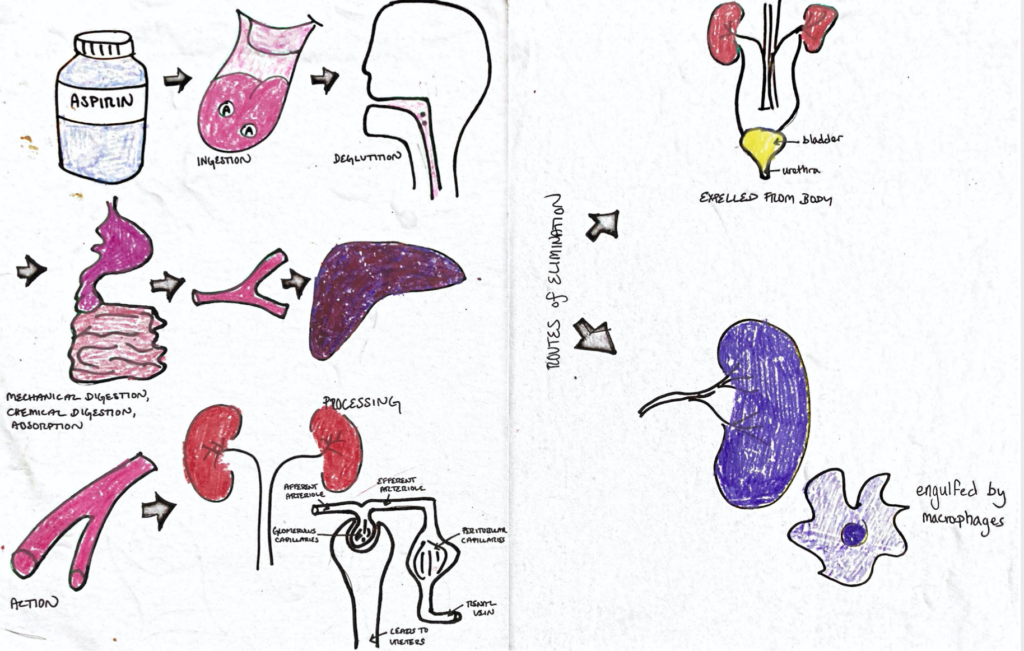
The Path of Aspirin Through the Digestive System
One marvels at the power of medicine and compliments a nutritious meal, but often passes over the complex workings of the body to empower our ingestions. Everyday millions of people consume aspirin tablets, an over the counter drug on the shelves of any grocery, convenience, or drug store, as part of their routine medication intake. How does the digestive system put this drug into effect?
Ingestion occurs as the tablets enter the oral cavity. No mechanical digestion, and minimal chemical digestion occurs in the mouth as the tablets are usually swallowed whole. Deglutition occurs next as the pharynx moves the pills into the esophagus in an act of propulsion. The pills are lubricated with mucosal secretions as they slide down the esophagus into the stomach, and salivary enzymes work to soften the tablet. In the stomach, mechanical digestion occurs by churning to break down the pills. Chemical digestion also occurs in the presence of hydrochloric acid. In addition, approximately 32% of the aspirin reacts with water and enzymes in a process known as hydrolysis, resulting in a water-soluble salicylic acid – the active ingredient in aspirin. The majority of aspirin absorption occurs in the stomach since aspirin is lipid-soluble, however, at a low pH of 6.5 none of it can be absorbed. Any salicylic acid resulting from hydrolysis in the stomach will move on to the small intestine where it will be absorbed into the bloodstream. In addition to the salicylic acid, any aspirin in its original molecular form that is left over is absorbed in the small intestine – the maximum amount of absorption occurring at pH 3.5 and 6.5. Once in the bloodstream, the 32% of salicylic acid begins to act. The liver must process the remaining 68% that was not hydrolyzed in the stomach via two metabolic pathways. The glucuronidation pathway adds a hydrophilic glucuronide group to the lipid aspirin molecules, resulting in salicyluric acid and salicyl pneolic glucuronide. In the oxidation pathway, a chemical reaction resulting in gentisic acid occurs in the presence of oxygen. These metabolites – salicyluric acid, salicyl pneolic glucuronide, and gentisic acid – perform the actions of aspirin in the blood by inhibiting cyclooxygenase which causes thromboxane A2, responsible for platelet clotting, to be blocked. They also block prostaglandins (lipid compounds responsible for regulating the body’s pain and inflammation). The medication has now accomplished its job, but how will its active ingredients be removed from the body?
As blood is filtered by the kidneys, some salicylate is excreted by glomerular filtration – the process by which fluid, ions, glucose, and waste products are removed from glomerular capillaries due to hydrostatic pressure (the pressure of blood in vessels). In a process known as tubular secretion, it is then transferred to renal tubular lumen to be eliminated in urine. The majority of salicylate, however, is reabsorbed and returned to the bloodstream through the peritubular and vasa recta capillaries in tubular reabsorption. Reabsorbed salicylate will continue to inhibit cyclooxygenase-one (COX-1), which is present on platelets, for 7-10 days (the approximate lifespan of a platelet). It will then be destroyed with the dead platelets in the spleen through phagocytosis of macrophages.

Great job in creating a detailed diagram of how aspirin is digested. As a very common medication, I feel like your project is able to show anyone who consumes aspirin what exactly is going on when they do so. Your written portion of your project is also very well written. You did a great job at describing every step aspirin takes through our digestive system and what happens to it in each step. From this presentation, I am able to take away that aspirin is mainly broken down in the stomach, as it is lipid-soluble, where it becomes its form of salicylic acid. It is later further absorbed into the body and remains in the body for 7-10 days.